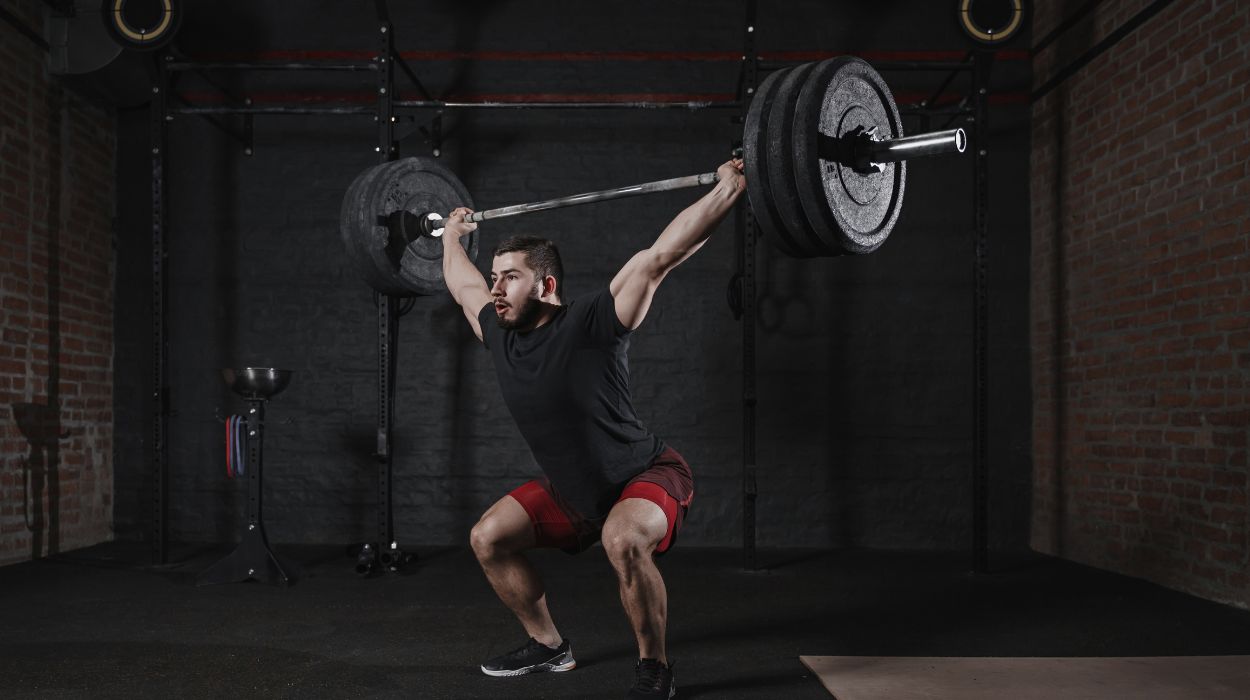Weight lifting, often associated with the sport involving two lifts, snatch and clean and jerk, using a loaded barbell, is frequently interchanged with weight training and strength/resistance training in everyday conversation.
Incorporating weight lifting for weight loss outcomes can be effective by increasing muscle mass and influencing composition. Studies[1] have also shown that regular strength training can help significantly reduce body fat percentage and overall body fat.
Some individuals may often wonder how much cardio is required in their training program. Including some cardio can further support weight loss outcomes; it’s worth noting that results can be achieved without it.
For most individuals, weight lifting refers to any exercise involving lifting weight, including gym equipment such as pin machines, dumbbells, and barbells.
Despite the sport-specific definition, in this article, we’ll use weight lifting broadly to encompass a wide range of exercises relevant to the larger population.
Best Weight Lifting For Weight Loss
There are five best methods to incorporate when looking to use weight lifting for your weight loss goals.
Focus on these key methods for best results:
- Focus on compound movements.
- Follow a well-structured program.
- Focus on building good habits and consistency.
- Seek proper guidance if you’re a beginner.
- Dial in your food intake to support your goals.
Weight Lifting For Weight Loss
Embarking on a weight lifting journey with the intent to achieve desired weight loss outcomes requires a well-rounded and sensible approach.
When individuals approach a strength training routine with consideration to the key factors detailed below, this ensures they progress in a safe manner. Such methods also allow individuals seeking weight loss to sustain results in the long term.
Read below to learn how to lose weight through strength training effectively.
Focus On Compound Movements

Compound movements are those that engage several muscle groups and joints. Common examples of compound movements include the squat, deadlift, and bench press. Aspects of weightlifting,[2] including the snatch, clean and jerk and their respective variations, are also considered compound movements.
Compound exercises should be the key aspect of strength training programs. They are an effective method to increase muscle strength and mass, positively influence body composition, and help decrease body fat.
The squat, deadlift, bench press, and row are all common staples in a strength program. However, a comprehensive program should also include essential movement patterns such as hinge, squat, and push and pull movements.
Follow A Well-Structured Program
Training programs can be structured in many ways. Factors that can influence the structure of a training program include training age, experience level, fitness level, time available, access to equipment, specific training goal, and so on.
A well-designed training program can make a big difference in outcomes and is particularly important if someone chooses to compete in the sport of weightlifting.
However, a well-structured strength training workout should address all major muscle groups in a way that is suitable for the individual’s current level[3] of fitness and strength.. These factors play a vital role in injury prevention.
The nature of designing a training program is limitless. While programming sessions may seem straightforward to some, if not done correctly, they could lead to the overuse of specific muscles or the development of a muscle imbalance.
While it may seem basic, programming can be complex. This process utilizes and manipulates many variables[4] to elicit physical adaptations; Therefore, seeking a proper program is pivotal to successful outcomes.
Generally, beginners should engage in a whole-body strength training program completed across 2-3 sessions per week. For intermediate and advanced individuals, programs can be divided into upper body and lower body days to build muscle.
In terms of weight loss, individuals can utilize a variety of programs. What’s important is that it’s well-balanced, targets all major muscle groups, is performed at an intensity appropriate to the individual level, and includes adequate rest time between working sets and recovery time between sessions to prevent fatigue and build muscle mass.
Focus On Building Good Habits And Consistency
While it can be easy to get caught up chasing the number on the scale, reaching for supplements, or setting weight loss targets to meet in specific time frames, building the desired habit to achieve your goals may serve you more long-term value.
Building consistency with your efforts can also support your weight loss goals. The scale can be unpredictable at times and often be influenced by various factors out of our control, giving off an inaccurate measurement of progress.
Moreover, if you are new to weight lifting, consistency will be vital for learning and developing the proper positions and movement patterns. When learning a new skill, constant repetition is paramount.
If you are lifting for weight loss, it’s important to remember that your results will be influenced by many factors. Maintaining consistency in your workouts will be productive, but only if other key influencing factors such as diet are also optimized.
Seek Proper Guidance If You’re A Beginner

If you are completely new to any type of weight lifting, and especially if you are also completely new to exercise in general, it would be incredibly beneficial to your overall development to engage proper guidance from the right professional.
Learning proper form in weight lifting is crucial to not only avoid injury, but ensure that you are engaging the correct muscles. By taking your time at the beginning to develop strong foundational movement patterns, you will also set yourself up for continued progress.
While some movements are simpler than others, everyone is mechanically different and may find certain movement patterns more challenging. Investing in a personal trainer can help lay the foundation to correct movement patterns and guide you to develop valuable body awareness.
If you don’t spend the appropriate amount of time establishing a solid foundation of all key movement patterns, you will most likely suffer the consequences down the track.
Improper form or technique[5] can lead to injury over time. It is also far less efficient and this will ultimately hinder your performance once you reach a certain point. For example, when you reach the point of being able to lift heavy weights, your technique will play a large role in being able to do so successfully.
Ultimately, If you establish and maintain poor form, there will come a time where you cannot progress any further, and in order to do so, the weight must be reduced completely to establish the correct technique.
Dial In Your Food Intake To Support Your Goals
We know that our diet plays a significant role in health and well-being. We also know that good nutrition not only supports the shorter term aspects relating to health, but also influences and shapes our long-term health too.
It is well known that diet is paramount in all aspects relating to body weight. Successful weight loss efforts rely on calorie intake,[6] as well as food quality. Whilst the most common aspect in weight loss is achieving a calorie deficit, the quality of those calories can also be an influencing factor.
While understanding how many carbs you should have per day to support your weight goals can be valuable knowledge, going deeper into topics such as knowing how to calculate net carbs may actually just add more complexity and clutter to the process. In turn, some people find themselves less motivated.
When it comes to weight loss, the most important aspect is simply a calorie deficit. Specific diet patterns and macronutrient distributions can be followed so long as the calorie deficit is maintained.
However, in the context of weight lifting, specific macronutrient distributions can impact aspects of performance, recovery, and rate of progress. Protein, carbohydrate, and fat intake should all be key considerations and tailored to the individual, to optimally support muscle growth and repair.
Ensuring an optimal intake of protein is essential for building muscle. Protein also contributes to satiety and has a higher thermic[7] effect, meaning the body utilizes more energy to digest it, which can contribute to metabolic rate.
So, an optimal diet[8] must incorporate adequate protein intake from lean sources, carbohydrates with at least half from whole-grain sources, healthy fats, dairy or dairy alternatives and plenty of fruits and vegetables. Ensuring you drink enough water to support good hydration levels is another essential component.
How Does Lifting Weights Help You Lose Weight?
Lifting weights promotes weight loss through several mechanisms. It increases energy expenditure during and after workouts and is pivotal in building and maintaining muscle mass.
A higher muscle mass in turn, results in a higher metabolic rate, which can further support weight loss efforts, as well as maintenance of body weight.
Integrating weight lifting into your fitness routine offers a comprehensive and effective strategy for achieving and sustaining weight loss goals.
How Much Weight Should You Lift To Lose Weight?
There isn’t necessarily an amount of weight that you should lift to lose weight. The amount of weight you can lift will ultimately depend on your level of strength.
Over time, by following a progressive training program and gradually challenging yourself, you will increase your strength levels and, in turn, the weight you can lift.
The key is to find a weight that is challenging enough to stimulate muscle growth and increase your metabolism but not so heavy that it compromises your form or leads to injury.
A good starting point is selecting a weight that allows you to perform 8-12 repetitions with proper form for each exercise. This rep range is often associated with hypertrophy,[9] the process of muscle growth, and can be effective for building strength and promoting weight loss.
Is Weight Lifting Good For Weight Loss?
Weight lifting for weight loss is a versatile and effective method that can be scaled and adapted to suit individual requirements. Furthermore, weight lifting is effective for fat loss in both females and males, providing a suitable strategy everyone can utilize and enjoy.
Beyond the physical benefits, it also positively impacts mood and confidence, making it a valuable component of a comprehensive weight loss plan.
Conclusion
Individuals may wonder whether cardio or weight lifting is the better choice for weight loss. Weight lifting offers a versatile and practical approach to weight loss, suitable for all and providing physical and mental benefits, providing a positive inclusion in a weight loss plan.
Frequently Asked Questions
Yes, you can successfully lose weight with weight lifting being your chosen form of physical activity. Strength training increases muscle mass, raises your metabolic rate and influences body fat levels. However, your diet must also be supportive of weight loss.
Yes, you can skip cardio and just lift weights. However, it’s worth mentioning that cardio can provide many positive physical and mental health benefits. Consider finding a method that you enjoy, such as circuit training, that still involves weights.
Yes, regularly lifting weights can increase your metabolism. Consistent efforts over time can increase muscle mass. A higher muscle mass requires more energy to maintain, which can also be referred to as an increased metabolic rate.
Results are entirely individual and will be influenced by various other factors. To set yourself up for optimal results, you need to ensure key factors such as sleep, stress, hydration, recovery, and diet are all consistently met.
 Evidence Based
Evidence Based
